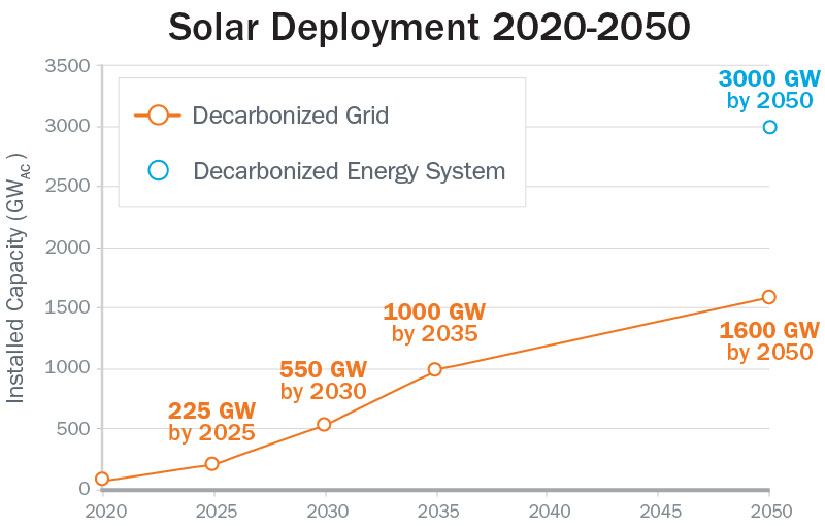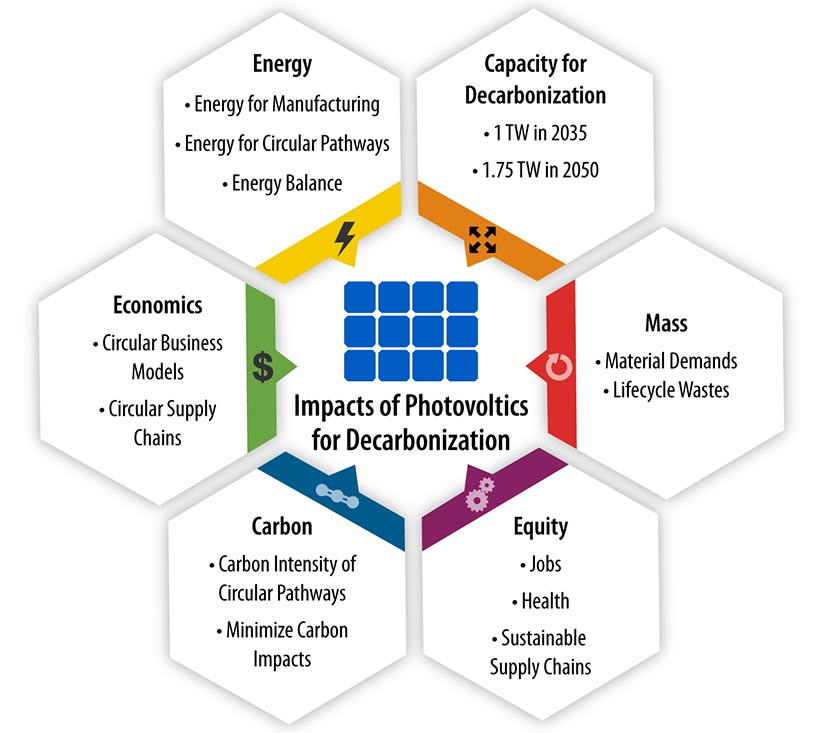Working Out the Details of a Circular Solar Economy
A New Software Model Helps Us Consider What To Do With End-of-Life Solar Modules, Guiding Us Toward a Circular Economy for These Materials
As solar grows rapidly as an energy source, the number of photovoltaic (PV) modules that are manufactured and installed each year will continue to expand. By 2050, the United States may have installed 1,600 gigawatts of PV (or more) to decarbonize its electricity system, about 20 times the amount installed today. Even before 2050, many of these PV modules may start retiring from service. What happens to those modules?

Many researchers and members of the PV industry, including researchers at the National Renewable Energy Laboratory (NREL), have begun to consider solutions to the end-of-life question for PV modules. Most envision a circular economy for PV materials in which modules (or the glass, silicon, aluminum, and other materials that compose them) are recaptured at the end of their life for reuse or recycling.
Show Me the Data
A more circular PV economy would both divert large quantities of PV waste from landfills and provide valuable source materials for new solar modules (thus reducing the scale of new resources that must be extracted and refined to develop a carbon-free energy system).
However, recent gatherings of PV experts on this topic have revealed a major stumbling block—end-of-life data for PV modules is sorely lacking. We do not know how many modules are being retired today, how they are being retired, or how these retirements affect the flow of PV materials.
"There is much interest in making PV, an already clean energy source, fully sustainable economically and environmentally," said Silvana Ovaitt, an NREL PV reliability researcher. "People jump to recycling as the solution, but for a product that is supposed to last more than 30 years—something more like a roof than a cell phone—that puts a big delay into the stream of recycled material. This gives us time to proactively plan for effective collection and recycling of modules. But it also points to the importance of alternate pathways of circularity for PV materials."
PV ICE Tackles Circular Uncertainty
Is it better to build more durable modules that last longer before needing replacement? Or are shorter-lived, fully recyclable modules a better approach? How could the evolution of PV technology, like thinner panels or new materials, play into a more circular economy?
These are some of the questions the PV in the Circular Economy (PV ICE) modeling tool is designed to help answer. PV ICE uses the latest data from the PV industry to model the flow of PV materials over the next several decades, helping predict the effects of different market trends, technological developments, and government policies.
Developed by a small team in NREL's PV Reliability Group, the open-source tool consists of two main pieces. The first piece is a set of data files that collect the key properties of today's PV modules—and predictions for future modules—including the quantities of different materials they contain, their expected lifetimes, and their power conversion efficiencies, among others.
PV ICE Development Team
- Heather Mirletz
- Silvana Ovaitt
- Dirk Jordan
- Kevin Anderson
- Mike Deceglie
- Acadia Hegedus
"Our goal was to create an 'average' crystalline silicon module," said Heather Mirletz, a Ph.D. student at Colorado School of Mines who helped develop PV ICE. "PV technology has evolved rapidly and continues to do so. So this 'average' silicon module also needs to evolve to accurately capture the materials going into and coming out of the field. I started by looking at market share over time for different types of cell and module designs and created averages of what a silicon module looks like from 1995 through 2030. I drew component material and module data from a number of different sources—industry and literature—to track cell and module changes. This technique could also be applied to a single manufacturer's bill of materials, though the PV module industry hasn't offered this type of materials transparency to date."
PV ICE's second key piece is a model of how these modules and the materials they contain will move through the PV life cycle. This includes projections of how many solar modules will be installed in future years and assumptions about key processes, such as manufacturing efficiencies or yields and rates of failure. Just as importantly, it also models the decisions of stakeholders and how these decisions might modify the flow of materials.
By varying process efficiencies and stakeholder decisions, PV ICE enables researchers to explore how improved reliability or different circular pathways—such as repair, reuse, remanufacturing, or recycling—could affect how much retired module material is landfilled and how much can be recaptured to help deploy more PV modules. The result is a detailed model of how materials enter, move through, and potentially exit a circular PV economy.
A More Powerful Lens for Studying Circularity
"This tool is unique because it brings the PV and the sustainability communities together in an interdisciplinary approach; we capture real-life industry practices like bifaciality, merchant tail, project lifetime, and degradation. It goes beyond a first-approximation approach of simple material-flow analysis," Ovaitt said.
For example, the PV ICE team found that several previous predictions had overestimated the rate at which today's modules will fail and require replacement. Field data (and system owners' willingness to sign longer and longer contracts) suggests modules are lasting longer. Updating this assumption in the PV ICE tool revealed that the volume of PV module waste will grow more slowly and arrive later than previously predicted.
"Our sensitivity analyses show that pre-2050 life cycle wastes are most sensitive to module lifetime and reliability," Mirletz said. "Virgin material demands are most sensitive to manufacturing yields. Circular economy pathways—'reduce, reuse, recycle'—are in order of impact, and our sensitivity results reflect and reinforce this ranking."

Expanding PV ICE for a Range of Applications
The team is working to add dimensions to PV ICE to capture other key areas of the circular economy. First up will be energy flows and financial factors, which will allow the team to examine the return on investment for different reuse or recycling approaches. After that, the team will use the mass and energy flows with life cycle assessment tools to calculate environmental impact and carbon intensity. Finally, it will be topped off with social impact metrics, which will consider job creation, wages, and worker safety of different circular economy approaches.
The resulting open-source tool will be useful to many different groups. Federal and state agencies might study the sustainability of their purchasing choices, research goals, and policies, and predict the timing of local PV waste. Module manufacturers could evaluate the long-term impacts of their new module designs, material choices, and supply chains, and better plan for end-of-life management (for instance, siting recycling facilities). PV system owners and their investors can better understand the effects of their choices as they finance new deployments or maintain (and retire) existing systems.
The goal is to quantify the flow of materials, energy, and carbon in the PV industry to help inform decisions that enable a more cost-effective and equitable circular economy.
Learn more about NREL's work on sustainability for photovoltaics.
